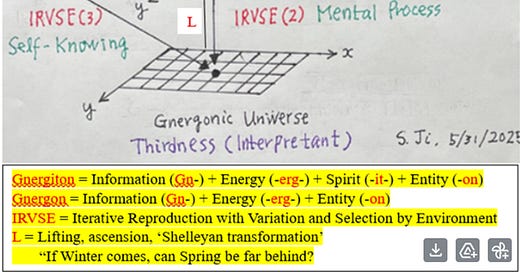From Silicon to Spirit: Mapping Federico Faggin’s Consciousness onto the Geometry of Reality
A comparative exploration of Faggin’s irreducible consciousness and the triadic geometry of mind, matter, and spirit
**By Sungchul Ji, Ph.D.**
Emeritus Professor of Theoretical Cell Biology
Rutgers University
Introduction
Federico Faggin—co-inventor of the microprocessor—has devoted his later years to understanding not machines, but consciousness. In his book *Irreducible*, he argues that consciousness is not a byproduct of matter, but its very origin. Meanwhile, the Geometry of Reality (GOR), a model I have proposed over decades of biological and philosophical inquiry, frames Reality as a triadic structure composed of Matter (X), Mind (Y), and Spirit/Consciousness (Z).
Can these two worldviews—one rooted in personal mysticism and cognitive science, the other in mathematical and biological metaphysics—be aligned?
This article proposes that they can. In fact, the concepts of Inner and External Consciousness in Faggin’s framework map naturally onto the Gnergitonic and Gnergonic universes in GOR. Moreover, his notion of a transpersonal field of consciousness corresponds closely to GOR’s Multiverse/Block Universe, the deepest generative layer of Reality.
The Core Proposals
Faggin’s View (as described in *Irreducible*):
· - Consciousness is primary, and all reality emerges from it.
· - Consciousness manifests in two forms:
· - Inner Consciousness (deep self, non-local, timeless)
· - External Consciousness (localized, perceptual, embodied)
· - Individual selves are nodes in a universal field of awareness.
GOR’s View:
· - Reality is triadic, consisting of three orthogonal axes:
· - X-axis: Matter (Iterative reproduction with variation)
· - Y-axis: Mind (selection)
· - Z-axis: Spirit or Consciousness (environment)
· - These axes generate three conceptual spaces:
· - Multiverse (XYZ-axis origin)
· - Gnergitonic Universe (XYZ volume: energy + information + spirit)
· - Gnergonic Universe (XY plane: energy + information)
Mapping the Models
We can interpret Faggin’s layered consciousness within the GOR coordinate system as follows:
Key Similarities
· Primacy of Consciousness: Both frameworks place consciousness at the heart of reality, not as an emergent epiphenomenon but as ontologically fundamental.
· Multiple Levels of Mind: Both distinguish between surface-level awareness and deeper spiritual or transpersonal aspects of mind.
· Reality as Structured: Faggin sees reality as layered fields of awareness; GOR formalizes this with a triadic vector space, making the structure explicit.
Key Differences
Why This Comparison Matters
GOR offers a structural bridge between the mystical and the measurable, the metaphysical and the material. Faggin’s work emphasizes subjective experience; GOR complements it with a framework that supports scientific generalization and triadic causality. When paired, they suggest that the deepest truths of the universe may be both irreducible and geometrizable.
Closing Thought
As we stand at the edge of physics, neuroscience, and philosophy, the convergence of thinkers like Faggin and models like GOR may herald a new Copernican revolution: not around the sun, but around the self-knowing cosmos [1].
References:
[1] Ji, S. (1991). The Shillongator: A Self-Knowing Universe. In: Molecular Theories of Cell Life and Death (S. Ji, ed.), Rutgers University Press, New Brunswick, N.J. Pp. 152-163, 230-237.
[2] Ji, S. (2018). The Cell Language Theory: Connecting Mind and Matter. World Scientific Publishing, New Jersey. Pp. 423-425.




